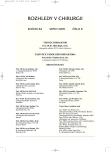Effect of Laser Irradiation of Diode Laser on Healing of Surgical Wounds in Rats
Vplyv laserového žiarenia diódového lasera na hojenie chirurgických rán u potkanov
Cieľom práce bolo nadviazať na predchádzajúcu štúdiu zaoberajúcu sa biostimuláciou hojenia kožných rán hodnotených po 24, 48, 120, 168 hodinách a tým skompletizovať chronologický priebeh procesu počas prvých siedmich dní. Do experimentu boli zaradené potkany – samce (n = 21) z rodu Sprague-Dawley. Zvieratá boli rozdelené do 3 skupín po 7 kusov. Po celkovej anestézii (kombinácia xylazínu, ketamínu a tramadolu) boli na oboch stranách chrbtice za aseptických podmienok vykonané dve 3,5 cm dlhé paralelné kožné incízie, ktoré boli následne zošité štyrmi jednoduchými stehmi. Rany na ľavo od chrbtice boli denne stimulované diódovým laserom (670 nm). Rezné rany na pravej strane chrbtice neboli ožarované a slúžili ako kontrola. Vzorky kožných rán boli odobraté na histopatologické vyšetrenie po 72, 96 a 144 hodinách od operácie. Vzorky boli farbené hematoxylínom a eozínom a histopatologicky vyšetrované.
Pri histomorfologickej štúdii vplyvu laserového žiarenia na primárne hojenie rán po 72, 96 a 144 hodinách bolo zistené, že rýchlosť hojenia stimulovaných rán je vyššia v porovnaní s kontrolnými ranami. Vyšetrením kožných incízií bol zaznamenaný skorší ústup zápalovej reakcie, rýchlejšie ukončenie reepitelizácie a pokročilejší priebeh maturačnej fázy hojenia. Predložená experimentálna práca doplňuje výsledky predchádzajúcej štúdie a dokazuje pozitívny vplyv biostimulácie na všetky fázy hojenie kožných rán in vivo.
Kľúčové slová:
biostimulácia – hojenie rán – potkany z rodu Sprague-Dawley – diódový laser
Authors:
B. Vidinský 1; P. Gál 1; T. Toporcer 1; M. Balogáčová 1; Ž. Hutňanová 1; R. Kilík 2; J. Bober 2; J. Sabo 1; F. Longauer 3
Authors‘ workplace:
Ústav lekárskej biofyziky, Lekárska fakulta Univerzity Pavla Jozefa Šafárika v Košiciach
Slovenská republika, prednosta ústavu doc. RNDr. J. Sabo, CSc.
1; I. chirurgická klinika, Lekárska fakulta Univerzity Pavla Jozefa Šafárika v Košiciach
Slovenská republika, prednosta kliniky prof. MUDr. J. Bober, CSc.
2; Ústav súdneho lekárstva, Lekárska fakulta Univerzity Pavla Jozefa Šafárika v Košiciach
Slovenská republika, prednosta ústavu doc. MUDr. F. Longauer, CSc.
3
Published in:
Rozhl. Chir., 2005, roč. 84, č. 8, s. 417-421.
Category:
Monothematic special - Original
Overview
The aim of this work was to continue in previous study, which concerns biostimulation of skin wound healing evaluated after 24, 48, 120, 168 hours and so complete the chronological continuance of the process during the first seven days. Male, Sprague-Dawley rats (n = 21) were used for the experiment. The rats were divided into 3 groups of 7 animals. In general anaesthesia (combination of xylazine, ketamine and tramadol) under aseptic condition two 3,5 cm long parallel skin incisions were performed on the left and right side of the rats spine and immediately sutured. The left wounds were daily stimulated with the diode laser (670 nm). The right wounds were not stimulated and served as control. The specimens of skin wounds were removed for histological evaluation 72, 96 and 144 hours after surgery. The biological specimens were stained with hematoxylin and eosin and histopathologically evaluated.
In summary, in our histomorphological study of the influence of laser irradiation on primary wound healing evaluated after 72, 96 and 144 hours was concluded, that the healing of stimulated wounds was accelerated in comparison with controls. The histological evaluation showed earlier regress of inflammatory phase, faster finishing of reepithelization and acceleration in maturation phase.
Presented experimental study completes the previous study and achieves the positive effect of biostimulation on all phases of skin wound healing in vivo.
Key words:
biostimulation – wound healing – Sprague-Dawley rats – diode laser
Labels
Surgery Orthopaedics Trauma surgeryArticle was published in
Perspectives in Surgery

2005 Issue 8
- Metamizole at a Glance and in Practice – Effective Non-Opioid Analgesic for All Ages
- Metamizole in perioperative treatment in children under 14 years – results of a questionnaire survey from practice
- Possibilities of Using Metamizole in the Treatment of Acute Primary Headaches
Most read in this issue
- Laparoscopic Surgical Procedures in Children with the Hirschprung’s Disease – Initial Experience
- Analysis of Surgical Procedures on the Vena Saphena Magna in the Czech Republic and an Effect of Detralex during its Stripping
- Modification of Surgical Treatment of Ingrowing Toenail
- Contemporary Trends in the Thoracic Surgery View to the History, Perspective
